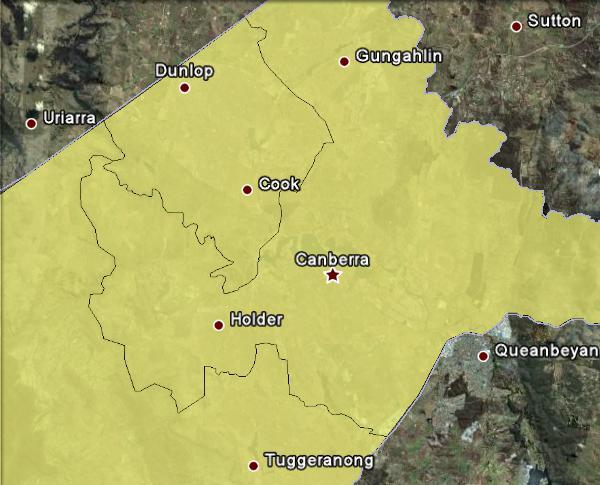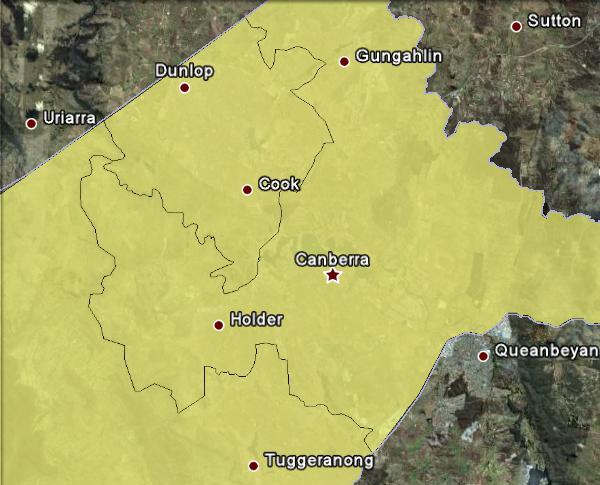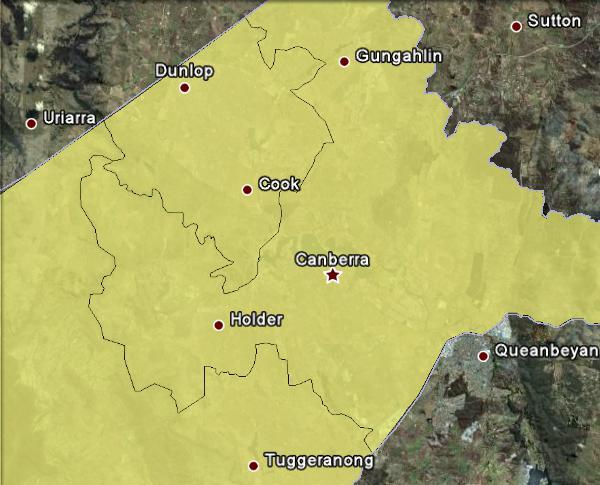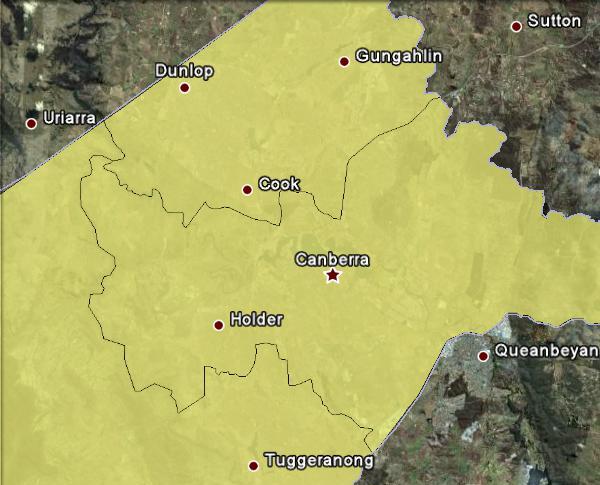Today Elections ACT announced new electoral boundaries that radically change the electoral boundaries used since 1995, and making very difficult or impossible for the Greens to retain all four of their seats at next year’s election.
I’ve posted analysis on the impact and maps of the changed areas below.
The ACT Legislative Assembly has existed in 1989 and since 1995 has been elected by voters in three multi-member electorates. These three electorates have been barely changed since the first drawing of boundaries before 1995. The redistributions before the 1998 and 2004 elections proposed no changes, while changes for 2001 and 2008 were very subtle.
Overall the structure has remained steady: a 7-seat electorate named Molonglo covering central Canberra, including South Canberra, North Canberra, Lake Burley Griffin, and the district of Gungahlin in the north; a 5-seat electorate named Ginninderra covering Belconnen in the north-west of the Territory, and Brindabella, covering Tuggeranong and the far south.
I have just expanded my collection of electoral maps to cover the 1995-1998 boundaries and the 2001-2004 boundaries, in addition to my map previously produced of the 2008 boundaries.
Since 1995, the major population shift in the ACT has been the growth of suburbs in the Gungahlin area at the northern end of Canberra.
The ACT Electoral Commission is currently conducting its redistribution in anticipation of an election in October 2012. The original draft dealt with the growth in the Gungahlin area by shifting more of Gungahlin into Ginninderra while leaving the boundaries mostly untouched.
These changes produced an outcry, with most submissions criticising Gungahlin being divided between the two electorates.
Today Elections ACT announced the report of the Augmented Electoral Commission’s report, which dramatically redrew the boundaries, ignoring both the original draft and 15 years of local electoral history.
Brindabella has been left untouched in the redistribution. In the north, Ginninderra has expanded dramatically, and is now a seven-member electorate, while the remnants of Molonglo will only elect five members. All of Gungahlin has been transferred to Ginninderra, as well as a number of suburbs in the inner north of Canberra, including Turner, Lyneham and O’Connor. Ginninderra now almost reaches Canberra’s city centre.
While the northern district of Gungahlin is now completely united with the neighbouring district of Belconnen, North Canberra has been split down the middle, with Northbourne Avenue now the border.
The new district of Molonglo Valley has been transferred from Ginninderra to Molonglo. While this area has a very low population at the moment, it is expected to take much of Canberra’s new population growth in coming years.
The main effect of the changes is to make it almost impossible for the Greens to maintain all of their four seats in 2012. In 2008, the Greens won a seat in Ginninderra and Brindabella, and won a second seat in Molonglo, increasing their numbers from one to four.
The new boundaries make the Greens seat in Ginninderra safer by adding strong Greens areas in the inner north and lowering the quota, but reduce the Greens vote in Molonglo to less than 1.2 quotas, which is far too low to elect a second Gree.
The Greens vote is lower in Ginninderra than in Molonglo, even after the redistribution, and the Greens would require a large swing to them to have a chance of gaining a second seat in Ginninderra.
On my calculations, these are the quotas in Ginninderra and Molonglo before and after the boundary changes:
| ALP | LIB | GRN | OTH | |
| Ginninderra 2008 | 2.41 | 1.67 | 0.83 | 1.09 |
| Ginninderra 2012 | 3.16 | 2.40 | 1.05 | 1.39 |
| Molonglo 2008 | 2.89 | 2.52 | 1.46 | 1.13 |
| Molonglo 2012 | 2.16 | 1.80 | 1.19 | 0.85 |
While Labor and the Greens would lose a seat each in Molonglo, Labor would gain a third in Ginninderra. The final seat in Ginninderra is unclear, but the favourite would be the Liberals, not the Greens, producing a result of 7 Labor, 7 Liberal, 3 Greens.
2008 was a very good result for the Greens, with a big swing and good luck in the Molonglo count. The best the Greens could have hoped for in 2012 would have been to solidify their hold on the seats they won in 2008. It seems very unlikely they would gain the large swing needed to win a second seat in Ginninderra.
It is hard, however, to know what would happen in the Hare-Clark system, where personal votes for individual MLAs is very important. None of the Green MPs had any experience in the Assembly in 2008, and you’d expect all of them to have developed personal votes, whereas in 2008 all were elected largely on the Greens party vote.
In particular, Caroline Le Couteur, who was elected as the second Green in Molonglo, was almost anonymous prior to the election. The Greens campaign in Molonglo had entirely focused on Shane Rattenbury. If Le Couteur were to run as a second Green in Ginninderra, personal votes for her and sitting MP Meredith Hunter could make things interesting.
The biggest irony with this draft redistribution is that, in the process of unifying the district of Gungahlin into one electorate, the Electoral Commission has broken apart the Inner North.
In recent years there have been discussions about increasing the number of seats in the Assembly, so that all electorates elect the same number of MPs. In particular, a model where all three electorates elected seven MPs has been considered. If such a model were to be implemented, it would be possible to largely keep both Gungahlin and the Inner North unified.
It would also eliminate the inequity where one electorate has a lower quota than the others, allowing more diverse representation. If Elections ACT shifts this privilege from the centre of Canberra to the outer north, it will remain an imbalanced way to elect the Assembly.
Due to the radical changes in the boundaries, Elections ACT has opened up another period for comments and objections, until 5 August. It is yet to be seen if they will return to a more modest change or stick to these boundaries.
Elsewhere: Antony Green.
Below I’ve posted maps showing the gradual change in ACT electoral boundaries since 1995.







Sounds like it is possible to elect a second Green in Ginniderra, with all of North Canberra added, but not a second in Molonglo. Sounds like it builds a case for making all electorates seven member. I was an ACT Green for 7 years and did a lot of campaigning in Belconnen.
Perhaps it would be simpler to not divide the Assembly into electorates.
If you want to divide the ACT up into electorates, perhaps it would be better to semi-fix these electorates on “natural” boundaries (without particular regard to population), and then allocate seats per electorate based on population. City, north, south might be appropriate here, particularly if it is fairly clear where one begins and the other ends.
Random chance may result in some areas being over/under represented slightly at each election, but this would probably even out over the long term.
There’s a few questions about Ginninderra that I doubt will be answered until election day.
Firstly, how much Stanhope’s personal vote is. It’s relevant because none of the sitting ALP members in Ginninderra aren’t Ministers (one was recently elected on countback). Mary Porter has a reputation of a good local member but she’s also been battling illness (same with John Hargraves in Brindabella). There might be a situation where there isn’t really any sitting members with a profile from the ALP.
Gunghalin has a reputation (whether correct or not) of being more conservative than the rest of the Molonglo electorate. The Labor base is in West Belconnen and does the introduction of the Inner North and Gunghalin dilute that.
The other variable factor for the ACT election will be if there’s the emergence of serious “independents”. They may be backed by community councils or residents groups focused on planning. It’s a major issue at the moment, especially in the Inner North and could suck votes from both the Greens and Labor. There’s also the potential of right-wing independents such the local talkback host Mark Parton running again for Ginninderra.
This is silly. The ACT is a small, fairly homogeneous place. Take away boundaries and elect all 17 MLA using a PR system like the d’Hondt method. From my rough calculations, the 2008 results most likely would have been identical to what they were under the current system.
The ACT Assembly used D’Hondt in the way you describe in 1989 and 1992, it was soon replaced with this system.
I think they have a very good system, I just think they should have more MLAs and equal numbers for each district. I would support either 28 seats or 21 seats.
Oh, I agree that the ACT has a good system … except for the fact that it’s divided into districts – I really can’t see a valid reason for doing so.
So pretty much we should be like the NSW Upper House with Robson Rotation?
Part of the problem is that all three parties don’t agree on changing the makeup of the Assembly. Labor and Greens support an increase but don’t agree on numbers. Liberals oppose an increase.
As a resident of the ACT, I think dividing Canberra into multiple electorates makes sense. It’s a pretty sprawled place yet the design means that people often live and work around the same town centre. The problem is the current division is that the 7 member electorate crosses more than one town centres e.g. Central Canberra and Gunghalin which fundamentally are different. They have different priorities and issues. In Gunghalin, the concerns are about facilities and getting a Govt Dept there for employment. In the Inner North, it’s about planning and higher density.
There are 2 reasons that the ACT Legislative Assembly is no elected at large.
Firstly, it would mean a lower quota of 5.55% (with 17 MLAs) compared to 12.5% and 16.67% in the electorates of the current system.
Secondly, STV is considered too unwieldy with the number of seats available above 11.
Interesting to note
At the 2008 ACT election the Greens got 15%
At the 2010 Federal election accross both of the ACT’s electorates they got 20%
And in the senate for the ACT they got 23%
This suggests there may be a lot of room for the Greens to gain further votes at this election considering they’ve done so well federally here.
Senate vote in 2008 reflected the quality of the candidate with good appeal to ALP voters and the chance o knocking off the Liberal Senate candidate.
There is no doubt that the Reps vote in 2008 was good – I think the Greens would be delighted if that was reflected in the 2012 Assembly vote. It certainly provides grounds for hope that a good campaign would see them hold their 2008 vote
The ACT is divided into districts because Ainslie and Amaroo have about as much in common as Balmain and Campbelltown do.
kme: I didn’t know Ainslie and Amaroo shared a football team? 😛
Sure they do, the Brumbies 😉
When the Coalition announce their Federal election policies, the Greens vote will skyrocket! Hockey let it slip on Q&A that 20,000 Commonwealth jobs would be got rid of in the ACT! Labor and the Greens should mention nothing else during the next Territory election campaign. A vote for the Liberals is a vote for huge job losses!
Ben, off quota figures of ALP 3.16 Lib 2.40 Green 1.05 Other 1.39 you write:
“While Labor and the Greens would lose a seat each in Molonglo, Labor would gain a third in Ginninderra. The final seat in Ginninderra is unclear, but the favourite would be the Liberals, not the Greens, producing a result of 7 Labor, 7 Liberal, 3 Greens.”
I’ve had a close look at the cutup for Ginninderra 2008 and in a seven seat system I suspect that Mark Parton, and not the Liberals, would win the seventh seat – rather easily in fact. In the five-seat cutup he started 1232 votes ahead of Lib 3 who despite the preferences of excluded ticket-mates had made no inroads when excluded. In a seven seat system the Stanhope surplus is larger and the Greens #2’s vote is mostly loose rather than being used up electing Green #1 (both these things add up to 200 to Parton). In the Libs’ favour Lib 1 goes over quota when Lib 4 is excluded, and probably with a surplus of at least 500 but that’s not enough to cancel out Parton’s lead over Lib 3.
Even assuming the Lib vote is higher and the Other vote lower proportionally as per your model (presumably since the boundaries are not the same) I think Parton still wins – additionally since Parton’s strong result is bumping the Ginninderra vote for “others” up compared to Molongolo, the assumption that the “others” vote would drop if the boundaries were changed is questionable.
Of course next election Parton might not run but a situation with the three big parties with less than half a quota of surplus above their secure quotas each is a dream scenario for an ungrouped independent to win. So I reckon the theoretical baseline result for this proposed redistribution is 7-6-3-1 not 7-7-3.
I saw d’Hondt was mentioned up the page as a PR system. D’Hondt is not truly proportional – it tends to skew in favour of larger parties/coalitions. Of course Hare-Clark with smallish numbers of members per electorate has a similar effect.
Don’t be silly Brenton,
EVERY new government promises to slash the public service…..I emember Team Rudd huffing and puffing about ‘fat cats’ in the run up to 2007. Then after a couple of years the PS just balloons out again.
I’m sure Canberra-ites are used to all the spin and hype, and know that after a few months of acting tough the new government will roll over and everything’s back to normal again.
Hey Ben!
There are just a few things that I would bear in mind here:
– In 2008, the Greens’ Shane Rattenbury, with quite a low profile prior to the election, secured nearly eleven per cent of the vote. He gained the third highest personal vote behind the Opposition Leader and the then Deputy Chief Minister. Since then, his profile has grown exponentially.
– Former Chief Minister Jon Stanhope retired this year. In 2008, he monopolised nearly one quarter of the vote in Ginninderra. With him out of the way, there are now many, many more votes to go around in Ginninderra.
– In 2008, the second highest personal vote in Ginninderra went to the Greens’ Meredith Hunter at just over 10 per cent. Aside from Hunter and Stanhope, every other candidate in Ginninderra polled in single digits.
– After her election in 2008, Meredith was named Leader of the Greens and has since had time to establish a profile through minority Government, which she lacked prior to 2008.
– Given all of this, it is inconceivable that Meredith’s personal vote won’t increase at the next election. Depending on how preferences flow, and, based on the Greens’ vote in the in the 2011 Federal Election, it is possible that they could secure two quotas in Ginninderra.
– If the new Chief Minister and former Deputy, Katy Gallagher, runs in Ginninderra, this would present a big impediment to the Greens’ chances there. However, it would make things much more straightforward for them in Molonglo, where she got the second highest personal vote behind the Opposition Leader.
– To conclude, while this is a little awkward for Shane Rattenbury and Caroline le Couteur, it is significantly more awkward for Katy Gallagher, Andrew Barr and Simon Corbell.
None of this is to say that I consider it likely that the Greens will retain four seats, but I don’t think it’s as difficult as you present it. You only need to survey the Canberra media to see that the Greens’ MLAs, particularly Meredith and Shane, have the highest profiles in the Assembly, barring the Chief Minister and the Opposition Leader. They are entering this election in a much stronger position than they were in 2008.
On another note, I’m extremely sceptical about the communities of interest argument in the context of the Hare-Clark electoral system. I have never met any Canberra resident who believes that they have a local member. I live in the Inner North, and I don’t believe that I have a ‘local member’ per se, there is no MLA that is accountable to me or my suburb.
When I worked in the Assembly, correspondence from constituents was typically addressed to all MLAs, or, to party spokespeople on particular issues. The ‘outcry’ you refer to was fairly benign. It was basically several individual submissions to Elections ACT made by members of the Gungahlin Community Council. It barely rippled within the ACT media.
submissions have gone in on this radical proposal – mostly opposed and from the north Canberra area. The gist of the submissions is that while the proposal solves the Gunghalin issue it does so at the expense of creating a similar problem with respect to North Canberra.
Discussion in the Canberra Times this morning.
The ACT Electoral Commission is holding a public hearing today at 3:00pm.
Interesting. I,d be interested to see your updated thoughts, noting the final decision on the boundaries – http://www.elections.act.gov.au/resources/uploads/pdfs/redistrib_11/Final_Redistribution_Report_2011.pdf
Comments are closed.